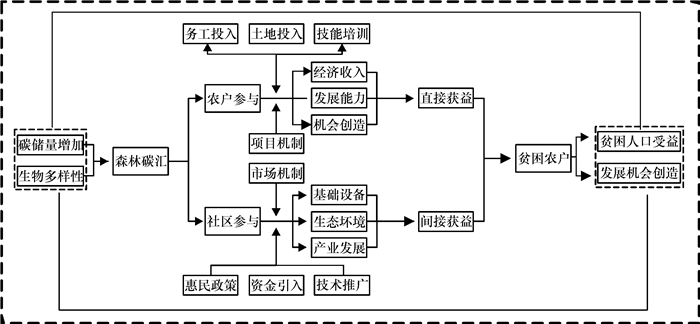Elite Capture and Mass Capture: Based on Empirical Evidence from Poverty Alleviation by Forest Carbon Sequestration
-
摘要: 森林碳汇扶贫是少数民族地区和贫困地区生态扶贫的重要抓手。为进一步挖掘森林碳汇扶贫功能、提升森林碳汇扶贫成效,有必要量化和剖析森林碳汇扶贫偏误。基于川西南、川西北两个地区的调查数据,借鉴精英俘获和大众俘获测量方法,探讨森林碳汇扶贫偏误的原因。囿于森林碳汇项目开发对精英群体示范带动作用的依赖,精英俘获现象在森林碳汇项目农户参与阶段明显,且在短时间内难以消除;大众俘获现象在利益分配阶段大量存在,且囿于项目运行机制和村落生态、社会、经济特征村落之间差异显著。减少森林碳汇扶贫偏误、提升森林碳汇扶贫成效的思路在于:参与阶段在允许一定精英俘获的背景下,通过精英群体与贫困群体的帮扶极大可能地增加贫困人口参与程度;利益分配阶段通过项目运行机制设计、易地搬迁、村组人才引进等措施降低大众俘获程度,增强贫困人口对森林碳汇所带来的基础设施改善等福利的获取。Abstract: The implementation of forest carbon sequestration for poverty alleviation in minority areas and poverty-stricken areas is an important grasp of poverty alleviation in minority areas and poor areas. It is necessary to quantify and analyze forest carbon sequestration poverty alleviation to further excavate the function and of improve the effectiveness of forest carbon sequestration. Based on the survey data of two regions in Southwest Sichuan and Northwest Sichuan, the regression analysis model is used to quantify the errors of the forest carbon sequestration through the measurement method of elite capture and mass capture. Because of the dependence on the demonstration and driving effect of the forest carbon sequestration project on the elite group, the phenomenon of elite capture is obvious in the stage of farmers' participation in the project of forest carbon sequestration, which is difficult to eliminate in a short time. The phenomenon of mass capture exists in the benefit distribution stage, and there is significant difference between villages due to the operation mechanism and the ecological, social and economic factors. The idea of reducing the error of forest carbon sequestration and improving the effectiveness of forest carbon sequestration is that, in the participation stage, it is possible to increase the participation of the poor population through the help of the elite group and the poor group under the background of allowing a certain elite capture, and that, in the benefit distribution stage, measures such as operation mechanism design, relocation, the introduction of talents from village groups can reduce the level of mass capture and enhance the poor's access to welfare benefits such as infrastructure improvement brought about by forest carbon sinks.
-
表 1 变量选择及释义
一级指标 二级指标 释义 类型 RE: 精英俘获程度 体制精英俘获程度 RE1 数值型 经济精英俘获程度 RE2 数值型 传统精英俘获程度 RE3 数值型 RD: 大众俘获程度 大众俘获程度 RD 数值型 V: 异质化程度 收入异质化程度 V1:家庭人均收入的方差值 数值型 职业异质化程度 V2:农业=0,务工或其他=1,求取全村方差值 数值型 居住分布集聚程度 V3:家庭离村委距离的方差值 数值型 De: 民主化程度 正式民主制度 De1:村民大会召开频率 数值型 非正式民主制度 De2:村规民约是否存在,是=1,否=0 分类型 L: 村组干部特征 户籍特征 L1:属于本村户籍=1,非本村户籍=0 分类型 受教育年限 L2:干部实际受教育年限 数值型 民主评价 L3: 样本农户主观评价均值 数值型 E: 资源禀赋 土地资源 E1:村庄耕地面积 数值型 人口分布 E2:村庄涵盖的民族数量 数值型 自然状况 E3:自然灾害发生频次 数值型 表 2 自变量特征分析
指标 综合 川西北 川西南 均值 方差 均值 方差 均值 方差 V1 0.106 2 0.002 2 0.098 9 0.002 7 0.113 8 0.001 7 V2 0.063 2 0.002 4 0.038 6 0.0008 0.088 8 0.002 9 V3 15.370 7 259.982 6 0.566 5 0.205 9 30.723 1 58.966 1 De1 3.163 6 0.769 0 3.214 3 0.767 2 3.111 1 0.794 9 De2 0.490 9 0.254 5 0.178 6 0.152 1 0.814 8 0.156 7 L1 0.454 5 0.252 5 0.178 6 0.152 1 0.740 7 0.199 4 L2 1.618 2 0.536 7 1.642 9 0.534 4 1.592 6 0.558 4 L3 3.163 6 0.769 0 3.214 3 0.767 2 3.111 1 0.794 9 E1 8.761 8 34.508 7 7.642 9 52.121 1 9.922 2 14.799 5 E2 0.693 2 0.177 7 0.440 6 0.202 4 0.955 1 0.018 9 E3 2.672 7 1.002 0 3.035 7 0.924 6 2.296 3 0.831 9 表 3 森林碳汇扶贫偏误描述性分析
指标 川西北 川西南 综合 均值 方差 均值 方差 均值 方差 RE1 0.094 1 0.000 1 0.096 7 0.000 4 0.095 4 0.000 3 RE2 0.203 6 0.000 6 0.198 3 0.001 6 0.201 0 0.001 1 RE3 0.059 5 0.001 6 0.125 4 0.000 7 0.091 9 0.002 3 RE 0.257 9 0.001 1 0.250 8 0.002 8 0.254 4 0.001 9 RD 0.560 9 0.400 7 0.399 4 0.104 0 0.530 7 0.151 4 表 4 森林碳汇扶贫偏误影响因素计量结果
变量 RE1 RE2 RE3 RE RD V1 0.121* 0.132** 0.043* 0.132* 0.103 V2 0.603** 0.107* 0.133* 0.302 0.315 V3 -0.305 -0.384* -0.036 -0.361* 0.267** De1 — — — — — De2 0.228* 0.248*** 0.280** 0.239** 0.485** L1 0.016*** 0.017* 0.025* 0.020* -0.181 L2 0.062 0.067 0.148 0.073 -0.139** L3 — — — — — E1 0.131 0.144 0.116 0.143 -0.048** E2 0.286* 0.312* 0.445*** 0.295** 1.138* E3 -0.013 -0.014** -0.132 -0.031* 0.071 R2 0.328 0.353 0.764 0.453 0.712 F 1.986 2.097 6.270 3.904 5.389 F(P) 0.063 0.030 0.000 0.029 0.000 说明:*、**、***分别表示在10%、5%、1%置信水平下显著;—表示被模型删除。 -
[1] 邢成举, 李小云. 精英俘获与财政扶贫项目目标偏离的研究[J]. 中国行政管理, 2013(9): 109-113. https://www.cnki.com.cn/Article/CJFDTOTAL-ZXGL201309025.htm [2] 胡联, 汪三贵, 王娜. 贫困村互助资金存在精英俘获吗——基于5省30个贫困村互助资金试点村的经验证据[J]. 经济学家, 2015(9): 78-85. https://www.cnki.com.cn/Article/CJFDTOTAL-JJXJ201509010.htm [3] 邢成举. 乡村扶贫资源分配中的精英俘获[D]. 北京: 中国农业大学, 2014. [4] 杨浩, 汪三贵. "大众俘获"视角下贫困地区脱贫帮扶精准度研究[J]. 农村经济, 2016(7): 79-83. https://www.cnki.com.cn/Article/CJFDTOTAL-NCJJ201607013.htm [5] 程璆, 郑逸芳, 许佳贤, 等. 参与式扶贫治理中的精英俘获困境及对策研究[J]. 农村经济, 2017(9): 56-62. https://www.cnki.com.cn/Article/CJFDTOTAL-NCJJ201709011.htm [6] 曾维忠, 张建羽, 杨帆. 森林碳汇扶贫: 理论探讨与现实思考[J]. 农村经济, 2016(5): 17-22. https://www.cnki.com.cn/Article/CJFDTOTAL-NCJJ201605003.htm [7] BENESSAIAH K. Carbon and livelihoods in Post-Kyoto: assessing voluntary carbon markets[J]. Ecological Economics, 2012, 77: 1-6. http://www.sciencedirect.com/science/article/pii/S0921800912000869 [8] CACHO O J, MARSHALL G R, MILNE M. Transaction and abatement costs of carbon-sink projects in developing countries[J]. Environment and Development Economics, 2005, 10(5): 597-614. http://www.researchgate.net/publication/231893672_Transaction_and_abatement_costs_of_carbon-sink_projects_in_developing_countries [9] DIYA DUTTA. Elite capture and corruption: concepts and definition[J]. National Council of Applied Economic Reseacher, 2009, 38: 48-52. http://www.ruralgov-ncaer.org/images/product/doc/3_1345011280_EliteCaptureandCorruption1.pdf [10] PAN L, CHRISTIAENSEN L. Who is vouching for the input voucher? decentralized targeting and elite capture in Tanzania[J]. World Development, 2012, 40(8): 1619-1633. http://www.sciencedirect.com/science/article/pii/S0305750X12000733 [11] 汪三贵, ALBERT PARK, SHUBHAM CHAUDHURI, et al. 中国新时期农村扶贫与村级贫困瞄准[J]. 管理世界, 2007(1): 56-64. https://www.cnki.com.cn/Article/CJFDTOTAL-GLSJ200701009.htm [12] 胡联, 汪三贵. 我国建档立卡面临精英俘获的挑战吗?[J]. 管理世界, 2017(1): 89-98. https://www.cnki.com.cn/Article/CJFDTOTAL-GLSJ201701010.htm [13] BARDHAN P, MOOKHERJEE D. Decentralizing antipoverty program delivery in developing countries[J]. Journal of Public Economic, 2005, 89(4): 102-117. http://www.sciencedirect.com/science/article/pii/S0047272704000969 [14] 邢成举. 精英俘获、自保逻辑与民主悖论——农村低保实施异化和指标错位原因透视[J]. 湛江师范学院学报, 2014(5): 157-163. https://www.cnki.com.cn/Article/CJFDTOTAL-ZJSX201405031.htm [15] 龚荣发, 曾维忠. 政府推动背景下森林碳汇项目农户参与的制约因素研究[J]. 资源科学, 2018(5): 1073-1083. https://www.cnki.com.cn/Article/CJFDTOTAL-ZRZY201805019.htm -





 下载:
下载:


